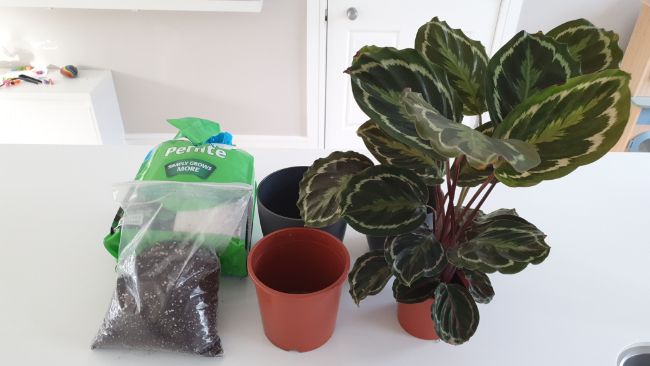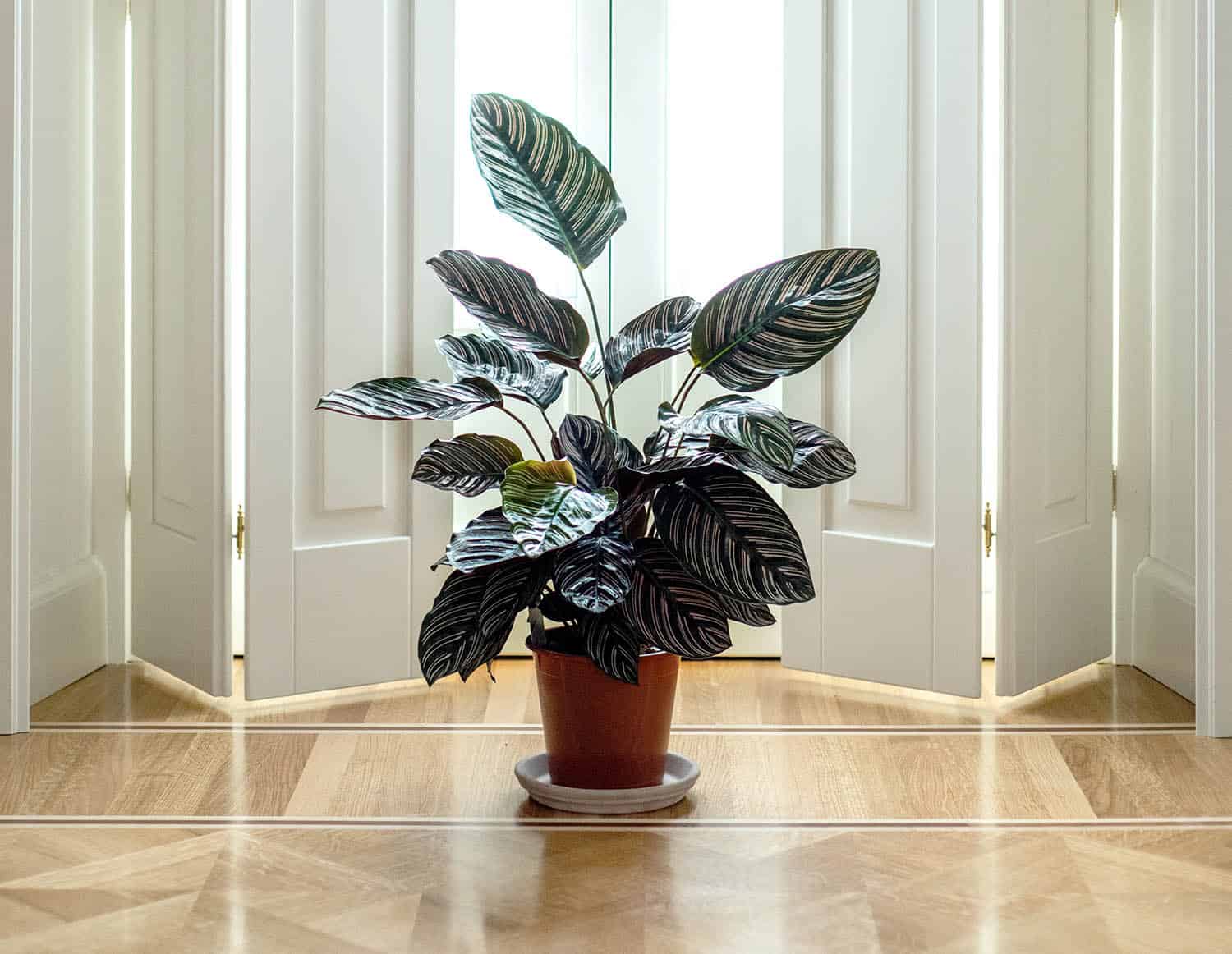To repot a Calathea, carefully remove the plant from its current pot, gently loosen the roots, and place it in a slightly larger pot with fresh potting mix. After repotting, water the plant thoroughly and place it in a location with indirect sunlight.
Adequate drainage is crucial to prevent waterlogging, so make sure the new pot has drainage holes. Calatheas are beautiful and vibrant houseplants that are known for their stunning foliage. Repotting is an essential step in maintaining the health and growth of these plants.
In this guide, we will walk you through the simple process of repotting a Calathea, ensuring that you do it correctly to avoid any stress or damage to the plant. From choosing the right pot to providing the ideal growing conditions, we will cover everything you need to know to successfully repot your Calathea plant. So, let’s get started and give your Calathea the best possible home for its thriving growth.

Credit: smartgardenguide.com
Factors To Consider When Selecting A Pot
Selecting the right pot for your Calathea when repotting is crucial. Consider the pot’s size, ensuring it provides enough space for the plant’s roots to grow. Drainage is also important to prevent water logging and root rot. Opt for pots with drainage holes or add a layer of gravel at the bottom.
The material of the pot is another factor to consider. Terracotta pots are breathable and help regulate moisture levels, while plastic pots retain moisture for longer. Choose a pot that suits your Calathea’s needs and promotes healthy growth. Keep these factors in mind to ensure your Calathea thrives after repotting.
Preparing The Pot For Repotting
Preparing the pot: Clean it thoroughly and sterilize it to ensure a safe environment. Check if drainage holes are present, and if not, add them for proper water flow.
Assessing The Health Of Your Calathea
Assess the health of your Calathea by checking if it is root-bound. Examine the roots for any signs of diseases or pests. Look for discoloration, rot, or any unusual growths. It is important to address any issues before repotting. Remove the plant from its pot and gently separate the roots.
If the roots are tightly packed and circling around the pot, it is a sign of being root-bound. Repotting it into a slightly larger container with fresh, well-draining soil will promote healthier growth. Inspecting the roots closely ensures the overall well-being of your Calathea.
Regularly monitoring the health of your plants is crucial to maintaining their beauty and vitality. Follow these steps to successfully repot your Calathea and keep it thriving for years to come.
Properly Watering Your Calathea Before Repotting
Properly watering your Calathea before repotting is essential for its overall health and successful transplant. One of the key techniques to keep in mind is allowing the soil to drain adequately. This prevents excess water from accumulating in the roots and causing root rot.
To achieve this, ensure your Calathea is potted in a well-draining soil mixture that allows water to flow freely. Before repotting, thoroughly water your plant to help loosen the roots and make the process easier. Water until it starts to drain out of the pot’s drainage holes.
Allow the excess water to fully drain before proceeding with repotting. By following these watering guidelines, you can ensure a smooth and successful Calathea repotting experience.
Gathering The Necessary Tools And Supplies
To repot a Calathea, gather the necessary tools and supplies: potting soil, garden gloves, and pruning shears. Prepare a pot with fresh potting soil, ensuring it provides good drainage. Put on your garden gloves to protect your hands while handling the plant.
Carefully remove the Calathea from its current pot, gently untangling any roots if necessary. Trim any damaged or overgrown roots with pruning shears. Place the plant in the new pot, adding more potting soil around it to support the roots.
Gently press the soil down to secure the plant. Water the Calathea thoroughly, allowing excess water to drain away. Find a suitable spot for your newly repotted Calathea, ensuring it receives adequate light and humidity. Regularly monitor the plant’s moisture levels and adjust watering accordingly.
With proper care, your Calathea will thrive in its new pot.
Step-By-Step Guide To Repotting Your Calathea
Repotting your Calathea is a simple process that requires careful attention. Start by loosening the root ball gently. Remove the Calathea from its old pot, ensuring not to damage the delicate root system. Take a close look at the roots and gently separate them if necessary.
Now, place the Calathea in its new pot, ensuring that it sits at the same depth as before. Backfill the pot with fresh potting soil, making sure that the roots are fully covered. Use light pressure to gently tamp down the soil.
After repotting, give your Calathea a thorough watering to help settle the soil and hydrate the plant. Following these steps will ensure a healthy home for your Calathea.
Adjusting The Lighting And Temperature Conditions
When repotting a Calathea, it’s important to consider the lighting and temperature conditions. Find an ideal spot that provides indirect sunlight for your Calathea, as direct sunlight can harm the plant. Place it in a location that receives bright, filtered light, away from windows with direct exposure to the sun.
Calatheas prefer a temperature range of 65-80°F (18-27°C), so make sure to keep it away from drafts or extreme temperature changes. Protecting your Calathea from direct sunlight is crucial in maintaining its vibrant colors and preventing leaf burn. By adjusting the lighting and temperature conditions and finding the perfect spot, you can ensure a healthy and thriving Calathea.
Maintaining The Moisture Levels
Maintaining the moisture levels of your Calathea plant is crucial for its overall health. Proper watering techniques are essential in ensuring that the soil moisture remains balanced. To monitor the soil moisture, insert your finger about an inch into the soil.
If it feels dry, it’s time to water the plant. On the other hand, if the soil feels overly wet or soggy, you should refrain from watering and allow the soil to dry out a bit. Remember to maintain a consistent schedule for watering your Calathea, but be mindful not to overwater as it can lead to root rot.
Consider using filtered or distilled water to prevent any potential mineral buildup in the soil, which can adversely affect the plant’s well-being. By implementing these watering practices, you can help your Calathea thrive and enjoy its lush, vibrant foliage.
Providing Adequate Humidity
Maintaining proper humidity levels is crucial for the well-being of your Calathea plant. To provide adequate humidity, consider placing a humidity tray near the plant. This tray can be filled with water, which will evaporate and increase the moisture in the surrounding air.
Additionally, misting the leaves regularly with water can also help to create a humid environment. It’s important to avoid overwatering the plant though, as this can lead to root rot. By following these simple steps, you can ensure that your Calathea thrives in its new pot.
Nurturing Your Calathea With Fertilizer
Caring for your Calathea involves fertilizing it to ensure its healthy growth. The first step is choosing the right fertilizer, which should be well-balanced and rich in nutrients. Make sure to establish a regular fertilizing schedule to provide your plant with consistent nourishment.
By following a schedule, you can avoid over-fertilizing and damaging the roots. It’s important to be mindful of the specific needs of your Calathea and adjust the frequency of fertilizing accordingly. Remember to use a variety of phrases at the beginning of the paragraphs to engage the reader.
Properly nurturing your Calathea with fertilizer is essential for maintaining its vibrant and lush appearance.
Frequently Asked Questions For How To Repot A Calathea
When Should I Repot My Calathea?
Repot your Calathea when its roots are overcrowded and filling the current pot, typically every 1-2 years.
What Kind Of Soil Does A Calathea Need?
Calatheas need well-draining soil with a good balance of moisture, organic matter, and nutrients.
Do Calatheas Like Big Or Small Pots?
Calatheas prefer small pots. Larger pots can cause overwatering and might stress the plant.
Do Calatheas Like Deep Pots?
Calatheas prefer deep pots as they have extensive root systems that need ample space.
Conclusion
Repotting a Calathea is an essential task for ensuring the health and longevity of the plant. By following the step-by-step process, you can provide a suitable environment for the roots to grow and allow the plant to flourish. First, choose a well-draining pot and the right soil mix.
Carefully remove the Calathea from its old pot, gently untangling the roots if necessary. Place the plant in its new pot, ensuring it is at the right level. Fill in the gaps with fresh potting soil and gently pat it down.
Finally, water the plant thoroughly and allow it to drain. Remember to keep your Calathea in a suitable location with indirect sunlight and regular misting to maintain its humidity requirements. With these tips, you can successfully repot your Calathea and provide it with the care it deserves.
Happy gardening!

